
Shirley Jakubowski has never been the shy type, especially when it comes to song and dance. After all, she sang solos in a Cincinnati women’s chorus for 27 years.
“I like music, and I like to think I can dance, even if I can’t,” she says, laughing.
But her confidence began to vanish in early 2008. “When I was first diagnosed with Parkinson’s, I didn’t want to tell anyone. If it hadn’t been for my husband pushing me, I would have just curled up in a corner and stayed there.”
Despite significant advances in treatment, Parkinson’s disease can cause tremors and increasing difficulty initiating movement. With her recent diagnosis, it seemed like a strange time for Jakubowski to start taking dance classes with a professional instructor.
But she and her husband weren’t attending just any ordinary ballroom dance or foxtrot class. They were part of Spokane’s first Dance for Parkinson’s class taught last fall. The program began as a joint effort between the Brooklyn Parkinson Group and the Mark Morris Dance Group, an international dance company based in New York. Inspired by the philosophy behind the program — using dance to break physical and social isolation for Parkinson’s patients — local dance instructor Terry Grizzell was determined to bring the project to Spokane. Last year he teamed with the Spokane Parkinson’s Resource Center to make that hope a reality.
“This brings them into a social setting and a community with the other members of the group,” Grizzell says. “They can relate to the symptoms [of Parkinson’s] and then break away from them.”
Each class begins with 40 minutes of warm-up movements. Participants sit in a circle practicing rhythm and flexibility exercises before Grizzell leads them through a series of dance combinations set to live piano accompaniment. Everything is based on the Mark Morris Group’s guidelines.
“The disease is really about the interruption of neuromuscular responses, so what we want to do through dance is reactivate those,” Grizzell says. “One symptom of Parkinson’s is to lose coordination and have periods of freezing where the body won’t move or has an uncontrolled shaking movement. What dance movement does is helps to develop a whole new body of work for them that channels away from those symptoms and into a whole different area.”
The class isn’t just helpful for people with Parkinson’s, though. Participants come to the class with family members or caregivers, who often leave having gained something themselves.
Jakubowski’s husband, Walter, says the class helps his balance and flexibility. Jay Warren, whose husband Bill was diagnosed eight years ago, says the class helps her emotionally as much as physically.
“The classes are a lot of fun. There’s a lot of kidding around and encouragement of each other. There’s a socialization aspect and the mutual support of other caregivers. We all get to know each other very well,” Warren says.
The program’s location in Gonzaga’s newly renovated dance studio has also given it a place in academia. Suzanne Ostersmith, Gonzaga’s dance program director, will begin to incorporate Dance for Parkinson’s into her Strategies for Dance Instruction course this fall. “Our dance program is a dance minor, but a lot of these students will go on to make careers in dance in different ways,” she says. “They love dance and want it to be a part of the rest of their lives, so giving them tools to teach different populations like this is just perfect.”
The program also intrigued Dr. Wendy Holmes, an Eastern Washington University associate professor and registered occupational therapist, as well as her students. “The science of if and why this is working isn’t really known, so we began by looking at the experience of the participants,” Holmes says. Like the caregivers, the dancers hailed the emotional and physical benefits of the class as equally useful.
“The only potentially negative comments were about their concerns for being able to perform the movements safely,” Holmes says. “And one individual spoke about how because people in the class are at various stages [of the disease] there was a little trepidation of seeing that experience. But overall, the responses were very positive. People are enjoying it and they see a real role for it in their lives.”
For Jay Warren and her husband, though, it doesn’t really matter if the science behind it all is still a little fuzzy.
“There may be no real definitive scientific evidence that dancing is significantly of help,” she says, “but he enjoys being with other people. I can’t say if it has greatly improved his movement, but he is more confident and comfortable.”
The Parkinson’s dance classes will resume in September. Visit spokaneparkinsons.org or call (509) 473-2490.

















